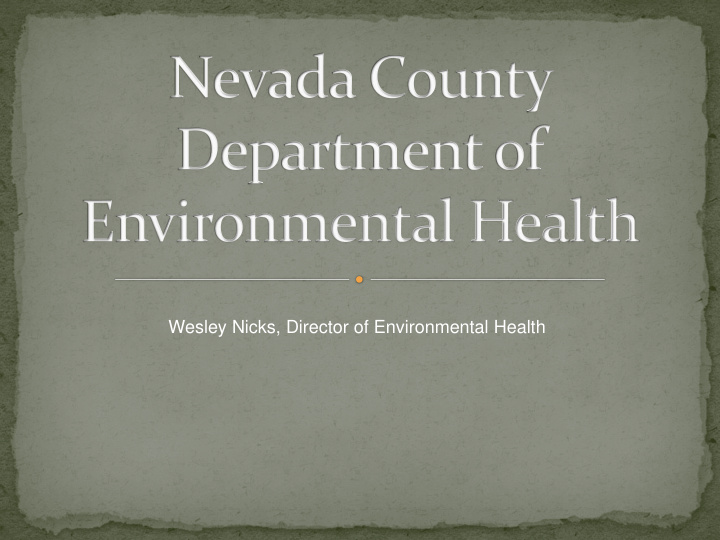



Wesley Nicks, Director of Environmental Health
Environmental Health Divisions Consumer Protection • Retail Food • Drinking Water • Vector Control • Recreational Health, Swimming Pools, Organized Camps Hazardous Material • Chemical Storage • Hazardous Waste Management • Underground and Aboveground Storage Tanks • California Accidental Release Prevention Program • Remediation and Emergency Response Land Use • Waste Water (On Site Septic Systems) • Change in Use Environmental Review (AML Sites)
Land Use Change or Development Application to Nevada County Planning Department Application is Complete Appropriate Zoning CEQA Compliance Review Planning Ensures Distribution to Appropriate Agencies Environmental Health Land Use Division Review • Waste Water Disposal Resources • Drinking Water Resources • Past Land Use Impacts Including AML
1,281 mining features of some kind. Features may or may not • be significant • Many of the historic mine records were never mapped • A minimum of 366 potential mine sites in Nevada County • 84% of 47,000 sites Statewide present physical safety hazards, approximately 11% environmental hazards • Approximately 31 percent are on private lands
ABANDO NDONE NED MI D MINE NE LA LAND ND PRELI LIMI MINA NARY A ASSESSME MENT NT (PA) P PROCESS DI DIAGRAM M INITIATE AML PA INVESTIGATION ° Determine Project Purpose ° Determine Project Objectives ° Request Phase I Assessment BACKGROUND RESEARCH PHASE I ° Records Review ° Site Inspection ° Interviews ° Update Conceptual Site Model With Results NO FURTHER ACTION ° No Physical Hazards ° Site Acceptable For Unrestricted Land Use FURTHER FURTHER ° Hazardous Waste Not Disposed INVESTIGATION INVESTIGATION at Site DECISION DECISION ° No Acid Mine Drainage ° No Potential Impacts to Water Quality (e.g., Turbidity) ° No Potential Impacts To The Environment From Past Uses SAMPLING PHASE II ASSESSMENT PHYSICAL HAZARDS ONLY EXTENSIVE CONTAMINATION IDENTIFIED ° Workplan Preparation ° CAL EPA/DTSC ° ° Sample Collection Required Engineered Mitigation ° Additional Sampling ° Refer Case to Cal EPA ° DTSC ° PEA Process ° NFA Concurrence DATA EVALUATION ° Accept / Reject Data ° Identify Data Gaps ° Compare to Background ° Compare Contaminants to Regulatory Levels MINOR MITIGATION POSSIBLE NFA FROM CAL EPA/DTSC ° Establish Pathways ° Comparison to Screening Data ° To Planning Department ° Background Comparison FURTHER ACTION REQUIRED CORRECTIVE ACTION PLAN ° ° Removal Action Define Problem ° ° Characterization/Remediation Describe Mitigation ° ° Reconsider Land Use Describe Verification of Results ° Conclusion and Recommendations
Recommend
More recommend